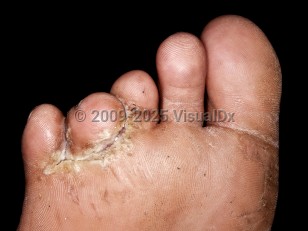Mixed toe web infection in Adult
Alerts and Notices
Important News & Links
Synopsis

A mixed toe web infection is an infection between the toes that is caused by a primary fungal infection and worsened by secondary bacterial superinfection.
The primary event in these infections is damage to the stratum corneum by dermatophytes. This is superseded by bacterial proliferation and secondary infection. The superinfection is commonly caused by the organisms, which are present even on normal skin, such as Staphylococcus aureus, Staphylococcus epidermidis, aerobic diphtheroids, Enterococcus faecalis, Acinetobacter, Klebsiella, Proteus, and Pseudomonas. Pseudomonas is the most commonly identified organism in gram-negative toe web infection, either alone or within a mixed gram-negative infection.
Bacteria and fungi are more likely to grow in warm, moist environments. Therefore, hot weather, excess sweating, athletic / recreational activities, and closed-toe / tight-fitting shoes can lead to mixed toe web infections, which can appear similar to Candida toe web infections, known as erosio interdigitalis blastomycetica.
Diabetes and smoking are predisposing risk factors for the development of mixed toe web infections.
These infections can be disabling, with the threat of cellulitis or septicemia in immunocompromised individuals, if not adequately treated.
The primary event in these infections is damage to the stratum corneum by dermatophytes. This is superseded by bacterial proliferation and secondary infection. The superinfection is commonly caused by the organisms, which are present even on normal skin, such as Staphylococcus aureus, Staphylococcus epidermidis, aerobic diphtheroids, Enterococcus faecalis, Acinetobacter, Klebsiella, Proteus, and Pseudomonas. Pseudomonas is the most commonly identified organism in gram-negative toe web infection, either alone or within a mixed gram-negative infection.
Bacteria and fungi are more likely to grow in warm, moist environments. Therefore, hot weather, excess sweating, athletic / recreational activities, and closed-toe / tight-fitting shoes can lead to mixed toe web infections, which can appear similar to Candida toe web infections, known as erosio interdigitalis blastomycetica.
Diabetes and smoking are predisposing risk factors for the development of mixed toe web infections.
These infections can be disabling, with the threat of cellulitis or septicemia in immunocompromised individuals, if not adequately treated.
Codes
ICD10CM:
B96.89 – Other specified bacterial agents as the cause of diseases classified elsewhere
SNOMEDCT:
402933000 – Gram-negative infection of toe web
B96.89 – Other specified bacterial agents as the cause of diseases classified elsewhere
SNOMEDCT:
402933000 – Gram-negative infection of toe web
Look For
Subscription Required
Diagnostic Pearls
Subscription Required
Differential Diagnosis & Pitfalls

To perform a comparison, select diagnoses from the classic differential
Subscription Required
Best Tests
Subscription Required
Management Pearls
Subscription Required
Therapy
Subscription Required
References
Subscription Required
Last Reviewed:05/02/2021
Last Updated:06/06/2021
Last Updated:06/06/2021
 Patient Information for Mixed toe web infection in Adult
Patient Information for Mixed toe web infection in Adult
Premium Feature
VisualDx Patient Handouts
Available in the Elite package
- Improve treatment compliance
- Reduce after-hours questions
- Increase patient engagement and satisfaction
- Written in clear, easy-to-understand language. No confusing jargon.
- Available in English and Spanish
- Print out or email directly to your patient
Upgrade Today

Mixed toe web infection in Adult

